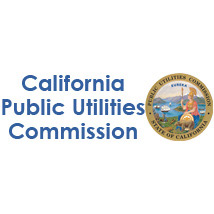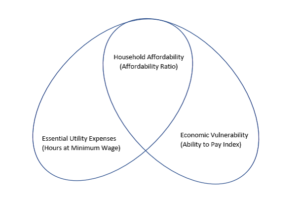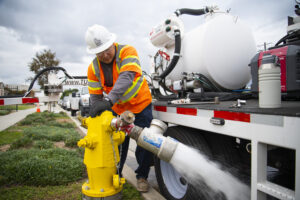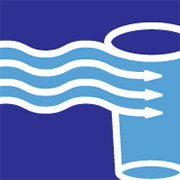California Public Utilities Commission (CPUC) staff from the Water, Energy, and Communications Divisions presented a comprehensive set of metrics for defining and measuring affordability of utility services at a workshop August 26 hosted by the CPUC. The recommendations are in connection with its Order Instituting Rulemaking (R.18-07-006) to assess the impacts on affordability of individual CPUC proceedings and utility rate requests.
Specifically, the goals of this proceeding are to:
- Develop a framework and principles to identify and define affordability criteria for all utility services under CPUC jurisdiction; and
- Develop the methodologies, data sources, and processes necessary to comprehensively assess the impacts on affordability of individual CPUC proceedings and utility rate requests.
Although the CPUC has regularly considered issues of affordability in a variety of forums, it currently lacks a working definition of what is meant by “affordable,” as well as a framework to consistently and comprehensively analyze affordability issues across individual proceedings and utility services. The CPUC intends to develop a range of metrics that can provide a comprehensive assessment of residential customers’ abilities to afford essential utility services.
At the August 26 workshop, staff proposed the following definitions of “Affordability” and “Essential Service”:
- Affordability: The degree to which a household can regularly pay for essential service of each public utility type (water, energy, communications) on a full and timely basis without substantial hardship. The more that a bill for essential service reduces a household’s ability to pay for other essential needs, the less affordable the utility service.
- Essential utility service: Service that meets a household’s basic needs and is reasonably necessary for that household’s health, safety, and full participation in society.
For water essential service, which is really “essential indoor service,” staff is recommending a quantity of 50 gallons per person per day, which is consistent with the 2018 “Conservation as a California Way of Life” legislation, as well as recent scholarly reports from policy organizations such as the Pacific Institute. The staff proposal also included similar approaches for telecommunications essential service and energy essential service.
With respect to “Affordability Metrics,” CPUC staff has determined that a holistic approach combining three different metrics is a reasonable policy direction. The three metrics are “Hours at Minimum Wage,” “Affordability Ratio,” and an “Ability to Pay” index.
Hours at Minimum Wage (HM) is exactly as it sounds: how long an individual needs to work at minimum wage to afford essential utility service. As an example, if the minimum wage is $12/hour and the cost of the three essential utility services is $200 per month, then the individual would need to work 16.7 hours in a month to pay for essential water, energy, and telecommunications service.
The Affordability Ratio (AR) takes the sum of the three services on an annual basis and divides that total by annual income less the annual cost of housing (income after housing costs or IAHC). Therefore, if the annual essential utility costs are $2,400 and the IAHC for a household of four is $30,000 ($50,000 – $20,000 = $30,000), then the AR is 12.5 ($30,000 ÷ $2,400).
The Ability to Pay Index (API) answers the question, “How vulnerable is a household in a given geographical area to high utility expenses?” First, each household type is assigned a vulnerability score, which is derived by calculating both a household’s income as a percent of the median income in a census tract, as well as the percentage of its income spent on housing, as reported in the American Community Survey. Then, the API is calculated as a weighted average of the vulnerability scores by household type in that census tract. A representation of the state might be:
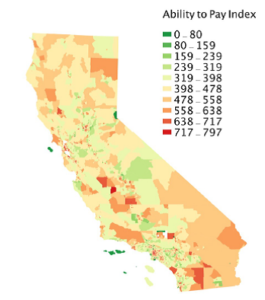
The Affordability Staff Proposal, goes on to estimate “proxy” bills for water, energy, and communications services and applies the metrics for two-person and four-person households in both urban and rural settings using the 265 “Public Use Microdata Areas” (PUMAs) in California. The results can then be applied to various CPUC proceedings such as general rate cases or recovery of balances in Catastrophic Event Memorandum Accounts. The strengths and weaknesses of each metric are summarized in the chart below:
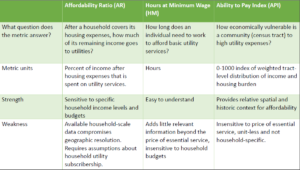
Because of the complexity of the proposal, the administrative law judge in the proceeding, Sophia Park, has given parties until September 10, 2019, to comment on the proposal with reply comments due 10 days later. The key issue for the parties will be the CPUC’s decision on how it will apply these metrics in future rate-setting proceedings.


